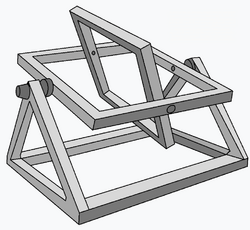Organization:Random positioning machine
 | |
| Other names | 3D clinostat |
|---|---|
| Uses | The RPM rotates biological samples around two independent axes to eliminate the effect of gravity. |
| Related items | clinostat, free fall machine |
A random positioning machine, or RPM, rotates biological samples along two independent axes to change their orientation in space in complex ways and so eliminate the effect of gravity.[1]
Description
The RPM is a more sophisticated development of the single-axis clinostat. RPMs usually consist of two independently rotating frames. One frame is positioned inside the other giving a very complex net change of orientation to a biological sample mounted in the middle. The RPM is sometimes wrongly referred to as the "3-D clinostat" (which rotates both axis in the same direction, i.e. both clockwise). It is a microweight ('micro-gravity') simulator that is based on the principle of 'gravity-vector-averaging'. RPM provides a functional volume which is 'exposed' to simulated microweight.[2]
Simulated micro-, partial, and hyper gravity
The concept of 'random' positioning has been used to simulate a micro-gravity environment through the nullification of gravity. This is accomplished by disorientating the target model, or as "vector-averaging". Through the use of a centrifuge, a 'hyper-gravity' gravity can be simulated, as the model will get exposed to a continued accelerated force.[3] In the circumstances of hyper-gravity within a micro-gravity environment, a partial 'Earth' gravity is created. Hyper-gravity simulation is also achieved through the use of larger centrifuges, such as the Large diameter Centrifuge (LDC) at the European Space Agency. The LDC simulated up to twenty times the Earth's gravitational strength. A system developed by Airbus uses an algorithm to simulate partial-gravity through a not fully randomly vector-averaging. The vector-averaging by Airbus' algorithm doesn't average out the vector to null but to a percentage representing simulated partial-gravity.[1][2][4]
Scientific Research
As the human body undergoes physiological changes once subjected to weightlessness or microgravity, space-related changes in physiology have come into the focus of scientific research. Experimenting aboard rockets during Sub-orbital flights or in ground-based facilities such as drop towers is not always feasible. However, technological advances made it possible to simulate microgravity in Random Positioning machines, which find vast implications in modern research.[5]
Disadvantages
The simulated microgravity environment attained inside the RPM is not perfect. A secondary effect part of this is the shear forces created by the fluid dynamics of the cell culture medium. They have been mathematically modeled by Wüest,[6] and according to the research by Hauslage,[7] they are of a magnitude enough to have biological implications. Also, Cortés-Sánchez showed these effects in mammalian cells cultured in the RPM.[8]
See also
References
- ↑ 1.0 1.1 Jack J.W.A. van Loon (2007). Some history and use of the random positioning machine, RPM, in gravity related research. Advances in Space Research 39: 1161-1165
- ↑ 2.0 2.1 A. G. Borst, J.J.W. A. van Loon. Technology and Developments for the Random Positioning Machine, RPM. Microgravity Sci. Technol., 2008. DOI 10.1007/s12217-008-9043-2
- ↑ van Loon, Jack J. W. A.; Krausse, Jutta; Cunha, Humberto; Goncalves, Joao; Almeida, Hugo; Schiller, Peter (June 2008). "The Large Diameter Centrifuge, LDC, for Life and Physical Sciences and Technology" (in en). Life in Space for Life on Earth 553: 92. ISSN 1609-042X. Bibcode: 2008ESASP.663E..92V. https://ui.adsabs.harvard.edu/abs/2008ESASP.663E..92V/abstract.
- ↑ Manzano, Aránzazu; Herranz, Raúl; den Toom, Leonardus A.; te Slaa, Sjoerd; Borst, Guus; Visser, Martijn; Medina, F. Javier; van Loon, Jack J. W. A. (2018-04-04). "Novel, Moon and Mars, partial gravity simulation paradigms and their effects on the balance between cell growth and cell proliferation during early plant development". npj Microgravity 4: 9. doi:10.1038/s41526-018-0041-4. ISSN 2373-8065. PMID 29644337.
- ↑ Wuest, Simon L.; Richard, Stéphane; Kopp, Sascha; Grimm, Daniela; Egli, Marcel (2015). "Simulated Microgravity: Critical Review on the Use of Random Positioning Machines for Mammalian Cell Culture" (in en). BioMed Research International 2015: 1–8. doi:10.1155/2015/971474. ISSN 2314-6133. PMID 25649075.
- ↑ Wuest, Simon L.; Stern, Philip; Casartelli, Ernesto; Egli, Marcel (30 January 2017). "Fluid Dynamics Appearing during Simulated Microgravity Using Random Positioning Machines" (in en). PLOS ONE 12 (1): e0170826. doi:10.1371/journal.pone.0170826. ISSN 1932-6203. PMID 28135286. Bibcode: 2017PLoSO..1270826W.
- ↑ Hauslage, Jens; Cevik, Volkan; Hemmersbach, Ruth (24 April 2017). "Pyrocystis noctiluca represents an excellent bioassay for shear forces induced in ground-based microgravity simulators (clinostat and random positioning machine)" (in en). npj Microgravity 3 (1): 1–7. doi:10.1038/s41526-017-0016-x. ISSN 2373-8065. PMC 5460110. https://www.nature.com/articles/s41526-017-0016-x.
- ↑ Cortés-Sánchez, José Luis; Melnik, Daniela; Sandt, Viviann; Kahlert, Stefan; Marchal, Shannon; Johnson, Ian R. D.; Calvaruso, Marco; Liemersdorf, Christian et al. (January 2023). "Fluid and Bubble Flow Detach Adherent Cancer Cells to Form Spheroids on a Random Positioning Machine" (in en). Cells 12 (22): 2665. doi:10.3390/cells12222665. ISSN 2073-4409. PMID 37998400.
External links
- ETH Space Biology Random Positioning Machine
- DESC VU Amsterdam Standard and desktop Random Positioning Machines
- Manufacturer's Website: yuri GmbH
 |
